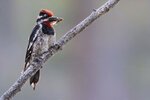
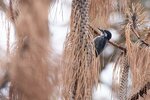
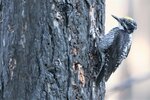
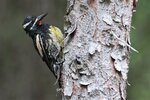
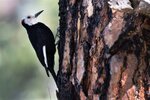
Thanks to the cartoon character Woody Woodpecker, the woodpecker family of birds is well-known, at least superficially. They make their living primarily by harvesting insects and other invertebrates that infest trees. This approach to life is very successful and there are multiple species of woodpeckers spread widely across the world.
Most woodpeckers share some anatomical features that are adapted to their foraging techniques. They look for prey with chisel-like bills designed to drill into trees and tear apart rotted wood. Their feet are adapted to climbing trees and branches, with their four toes arranged two-up and two-down which balances weight and strength while climbing and holding on while drilling.
But their most interesting adaptation is their long sticky tongue. Within the skull, this long tongue wraps around the bird’s head. It can be extended far into a wood cavity to extract prey. Some species have the ability to wrap the tip of the tongue around the prey before extraction.
Not all woodpecker species, however, depend on drilling. Washington State has multiple woodpecker species whose feeding techniques are not focused on drilling and tearing apart rotting trees. Some of these species are encountered primarily in the mountains and eastern portion of our state and, because they are interesting and attractive, I thought you would like to know more about them. Liam’s photographs that accompany this column show off many of their features.
One species, the White-headed Woodpecker, is glossy black and has a mostly white head and face. It’s a robin-sized bird and is most likely seen clinging vertically to a pine tree. The sexes look alike, except that males have a red slash across the back of the head. This species feeds on pine nuts and is found year-round in the old-growth Ponderosa Pine habitats of Eastern Washington.
These woodpeckers are sometimes seen in areas of recent burns where they flake off pieces of bark, seeking insect prey. They nest in cavities and, interestingly, both sexes share in the brooding of eggs.
There are two other woodpecker species that also invade burn areas, the Black-backed Woodpecker and the American Three-toed Woodpecker. In fact, the Black-backed Woodpecker is found almost exclusively in burned areas. They seek out these areas and, once found, occupy them for five or more years, taking advantage of the abundant wood-boring insect larvae. Their black back blends in with the burned bark and may offer some degree of protection from predators.
The sexes are more-or-less identical; however, males have a yellow crown patch. I know people who are familiar with this species, not because they are bird lovers but because they are mushroom lovers. It seems that morel mushrooms respond to a burn with an abundance of fruiting bodies and hence an abundance of morel hunters. So, by tramping a recent burn, you might encounter two interesting species, one avian and one for gourmet cooking.
The Three-toed Woodpecker would seem to be closely related to the black-back; both species have only three toes, two forward and one back. And they both are sedentary, occupying a territory year-round as long as it provides sufficient food. These species can endure harsh winters so long as their preferred food is available.
The three-toed, however, is smaller than the black-backed and has variable white feather patterns on its back. Sexes are alike, with the male exhibiting a yellow cap. This species specializes in harvesting the larvae of the Spruce Bark Beetle. Thus, it may roam into new areas in response to outbreaks of this beetle, as well as recent burns. Rather than drilling, they also use their bills primarily to flake off bark, looking for prey.
Finally, there are two species of sapsuckers found in Eastern Washington. One is the Red-naped Sapsucker. These woodpeckers have a taste for sugary sap, and for the insects that are also attracted to oozing sap. They drill rows of holes in willows, birch, and aspen trees, lapping up the sap and insects alike. The sexes are alike; they are black and white robin-sized birds with dramatic black, white and red heads (the female’s red markings are less dramatic). They have a red patch at the base of the neck. You might also notice a yellowish wash across the belly. Many years ago, these birds were given the same name as the Yellow-bellied Sapsucker of the Eastern U.S. Now they are a separate species.
One final species, the Williamson’s Sapsucker, is found in the mountains and is my favorite woodpecker species because, in contrast to almost all other woodpeckers, the males and females look nothing alike. The males are dramatic – black body and back, with white face stripes and wing patches and a lemon yellow belly; they also have a small red throat patch. When you see them, they are unmistakable.
The females, in contrast, are non-descript and easily mistakable. They have a finely barred black and white back, a brown unmarked head, and a black breast patch. In my early bird-watching days, this fact resulted in my spending fruitless hours trying to identify the brown woodpecker species I was seeing. I thought I had found a new species!
George Walter is environmental program manager at the Nisqually Indian Tribe’s natural resources department; he also has a 40+ year interest in bird watching. He may be reached at george@theJOLTnews.com.
Photos for this column are provided by Liam Hutcheson, a 16-year-old Olympia area birder and avid photographer.
2 comments on this item Please log in to comment by clicking here
HPressley
Thanks for your columns, I really enjoy them. I was wondering if it is possible to have pictures of both males and females when the species is dimorphic. It would help me when I try to identify them. Thanks!
Friday, July 7, 2023 Report this
Callie
I once read in Outside magazine (at the dental office) that woodpeckers have to close their eyes to peck or the force of the banging will make their eyeballs fall out. Is this true?
Wednesday, July 12, 2023 Report this